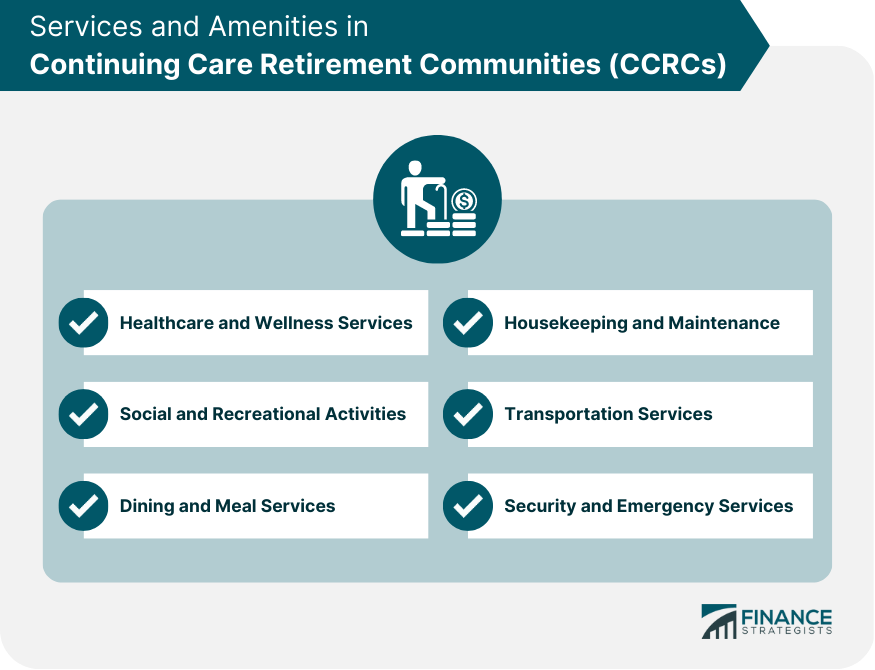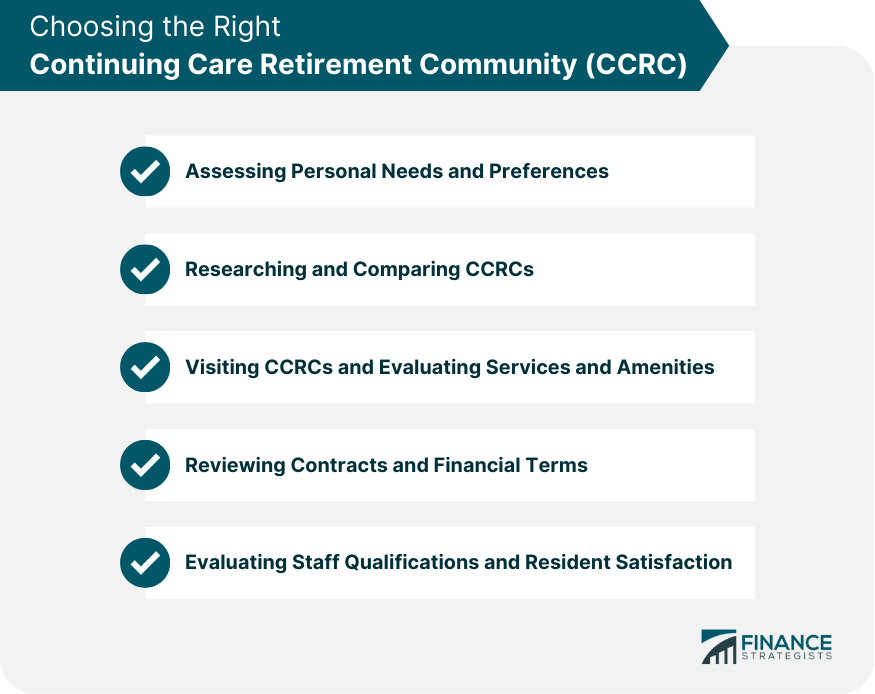A CCRC is a residential community designed for seniors that offers a range of housing options, services, and healthcare facilities. These communities aim to provide a continuum of care that accommodates the changing needs of residents as they age. CCRCs are designed to provide seniors with a comfortable, secure, and engaging environment that promotes social connections, independence, and access to healthcare services. The primary benefits of CCRCs include continuity of care, a sense of community, and a variety of services and amenities that cater to residents' needs. CCRCs typically offer a range of services and amenities, including healthcare and wellness services, social and recreational activities, dining and meal services, housekeeping and maintenance, transportation services, and security and emergency services. Independent living units within CCRCs provide seniors with private residences, such as apartments or cottages, where they can live independently while enjoying the community's amenities and services. These accommodations are designed for seniors who are still active and able to manage their daily activities without assistance. Assisted living residences within CCRCs offer a higher level of care and support for seniors who require assistance with daily activities, such as bathing, dressing, or medication management. These accommodations typically include private or semi-private apartments and access to the full range of services and amenities available within the community. Skilled nursing care facilities within CCRCs provide round-the-clock medical care and support for seniors with significant healthcare needs or those recovering from illness or surgery. These facilities offer private or semi-private rooms, as well as access to specialized medical services and therapies. Memory care units within CCRCs cater to seniors with Alzheimer's disease or other forms of dementia. These specialized facilities offer a secure and supportive environment, along with tailored care plans and programming designed to address the unique needs of residents with cognitive impairments. CCRCs offer a variety of healthcare and wellness services to support the physical and mental well-being of residents. These services may include on-site medical care, medication management, rehabilitation and therapy services, and wellness programs. To promote social connections and an active lifestyle, CCRCs offer a range of social and recreational activities for residents. These activities may include clubs, classes, outings, and special events tailored to the interests and abilities of residents. CCRCs typically provide residents with dining and meal services, which may include communal dining areas, meal plans, and special dietary accommodations. Some communities may also offer on-site cafes or restaurants for additional dining options. To ensure a comfortable and well-maintained living environment, CCRCs provide housekeeping and maintenance services for residents. These services may include cleaning, laundry, and routine maintenance and repairs for residences and common areas. CCRCs often offer transportation services to help residents access off-site appointments, shopping, and recreational activities. These services may include scheduled shuttles, group outings, or individual transportation arrangements. To ensure the safety and well-being of residents, CCRCs provide security and emergency services, such as on-site security personnel, emergency call systems, and access to emergency medical care. When considering a CCRC, it's essential to understand the various types of contracts and fees associated with these communities. Common financial arrangements include: Entrance fees are one-time, upfront payments required upon joining a CCRC. These fees can vary significantly depending on the community, the type of residence, and the level of care provided. In addition to entrance fees, residents of CCRCs are typically required to pay monthly fees that cover the cost of housing, services, and amenities. These fees may vary based on the specific services and care levels provided. Under a fee-for-service contract, residents pay lower entrance and monthly fees but are responsible for the cost of any additional healthcare services they require. This type of contract may be suitable for those who have additional insurance coverage or wish to minimize upfront costs. A life care contract typically involves a higher entrance fee and monthly fees but guarantees access to healthcare services at no additional cost for the duration of the resident's stay in the community. This type of contract may provide greater financial predictability and peace of mind for residents and their families. The cost of CCRCs can vary based on factors such as the type of residence, the level of care provided, the location of the community, and the specific services and amenities offered. When considering a CCRC, it's crucial to carefully review the costs and financial commitments associated with these communities. Financial planning and insurance options, such as long-term care insurance or annuities, may help offset the costs of living in a CCRC. CCRCs are subject to various state and federal regulations that govern the operation of these communities and the care provided to residents. It's essential to ensure that a CCRC meets all applicable regulatory requirements and maintains the appropriate licenses and certifications. In addition to meeting regulatory requirements, some CCRCs may also seek voluntary accreditation or certification through organizations such as the Commission on Accreditation of Rehabilitation Facilities (CARF) or the Continuing Care Accreditation Commission (CCAC). Accreditation and certification can provide an additional measure of confidence in the quality of care and services provided by a CCRC. Resident Rights and Protections It's essential for residents and their families to be aware of the rights and protections afforded to them within a CCRC. This may include the right to privacy, the right to participate in decisions about one's care, and the right to voice concerns or grievances without fear of retaliation. CCRCs offer seniors an enhanced quality of life by providing comfortable living arrangements, a wide range of services and amenities, and a supportive community of peers and staff. One of the primary benefits of CCRCs is the continuity of care they provide, ensuring that residents can access the appropriate level of healthcare services and support as their needs change over time. CCRCs foster social connections and community involvement by offering a variety of social and recreational activities that encourage residents to engage with their peers and participate in the community. By offering comprehensive care, services, and support, CCRCs provide peace of mind for residents and their families, knowing that their needs will be met as they age. One of the main challenges associated with CCRCs is the high cost and financial commitment required to join and reside in these communities. This may be prohibitive for some seniors and their families, making it essential to carefully consider one's financial situation and explore various financing options. Due to high demand for CCRCs, there may be limited availability and long waitlists for specific communities or levels of care. This may require seniors and their families to plan ahead and consider alternative options if necessary. Transitioning to a CCRC may require seniors to adapt to new living arrangements and community life, which can be challenging for some individuals. It's essential to carefully evaluate one's personal needs and preferences when selecting a CCRC to ensure a smooth transition and successful adjustment. When selecting a CCRC, it's essential to consider one's personal needs and preferences in terms of care, services, and living arrangements. This may involve evaluating one's healthcare needs, lifestyle preferences, and desired community atmosphere. Before making a decision, it's important to research and compare different CCRCs to find the best fit. This may involve gathering information about the communities' services, amenities, and costs, as well as reviewing resident satisfaction ratings and accreditation status. To gain a better understanding of a CCRC's offerings and environment, it's helpful to visit the community in person. This provides an opportunity to tour the facilities, meet staff and residents, and observe the quality of services and amenities firsthand. Before committing to a CCRC, it's crucial to carefully review the contract and financial terms to ensure a clear understanding of the costs and commitments involved. This may involve seeking legal or financial advice to help navigate the complexities of CCRC contracts. To ensure a high quality of care and support, it's essential to evaluate the qualifications of the CCRC staff and the overall satisfaction of current residents. This may involve asking about staff training and certifications, as well as speaking with residents about their experiences within the community. CCRCs play a crucial role in providing a comprehensive care solution for seniors, offering a range of living arrangements, services, and healthcare facilities designed to meet the diverse needs of an aging population. When selecting a CCRC, it's essential to consider factors such as personal needs and preferences, the quality of care and services provided, and the financial commitments involved. By carefully evaluating these factors, seniors and their families can make informed decisions about the right CCRC for their needs. As the senior population continues to grow, CCRCs will play an increasingly important role in meeting the diverse needs of the elderly, providing comfortable living environments, comprehensive care, and supportive communities that promote well-being, independence, and social connections.What Is a Continuing Care Retirement Community (CCRC)?
Types of Living Arrangements in CCRCs
Independent Living
Assisted Living
Skilled Nursing Care
Memory Care
Services and Amenities in CCRCs
Healthcare and Wellness Services
Social and Recreational Activities
Dining and Meal Services
Housekeeping and Maintenance
Transportation Services
Security and Emergency Services

Financial Considerations for CCRCs
Types of Contracts and Fees
Entrance Fees
Monthly Fees
Fee-For-Service Contracts
Life Care Contracts
Factors Affecting Cost
Financial Planning and Insurance Options
Legal and Regulatory Considerations
State and Federal Regulations for CCRCs
Accreditation and Certification Requirements
Benefits of CCRCs for Residents and Families
Enhanced Quality of Life
Continuity of Care
Social Connections and Community Involvement
Peace of Mind for Residents and Their Families
Challenges and Potential Drawbacks of CCRCs
High Cost and Financial Commitment
Limited Availability and Waitlists
Adjusting to New Living Arrangements and Community Life
Choosing the Right CCRC
Assessing Personal Needs and Preferences
Researching and Comparing CCRCs
Visiting CCRCs and Evaluating Services and Amenities
Reviewing Contracts and Financial Terms
Evaluating Staff Qualifications and Resident Satisfaction

Conclusion
Continuing Care Retirement Community (CCRC) FAQs
A CCRC is a residential community for older adults that provides a continuum of care, ranging from independent living to assisted living to skilled nursing care, all in one location.
CCRCs differ from other retirement communities in that they offer a continuum of care. Residents can move from independent living to higher levels of care as their needs change, without having to leave the community.
A CCRC may be right for you if you are looking for a community where you can age in place and have access to a continuum of care. It is important to do research and visit several communities to find one that meets your needs and preferences.
CCRCs are typically regulated by state agencies, and may be subject to additional accreditation standards from organizations like the Commission on Accreditation of Rehabilitation Facilities (CARF) or the Continuing Care Accreditation Commission (CCAC).
The costs of living in a CCRC can vary widely depending on the location, amenities, and level of care needed. Many CCRCs require an entrance fee, which can range from tens of thousands to hundreds of thousands of dollars, as well as monthly fees that cover services and amenities. It is important to carefully review the costs and financial arrangements before choosing a CCRC.
True Tamplin is a published author, public speaker, CEO of UpDigital, and founder of Finance Strategists.
True is a Certified Educator in Personal Finance (CEPF®), author of The Handy Financial Ratios Guide, a member of the Society for Advancing Business Editing and Writing, contributes to his financial education site, Finance Strategists, and has spoken to various financial communities such as the CFA Institute, as well as university students like his Alma mater, Biola University, where he received a bachelor of science in business and data analytics.
To learn more about True, visit his personal website or view his author profiles on Amazon, Nasdaq and Forbes.











